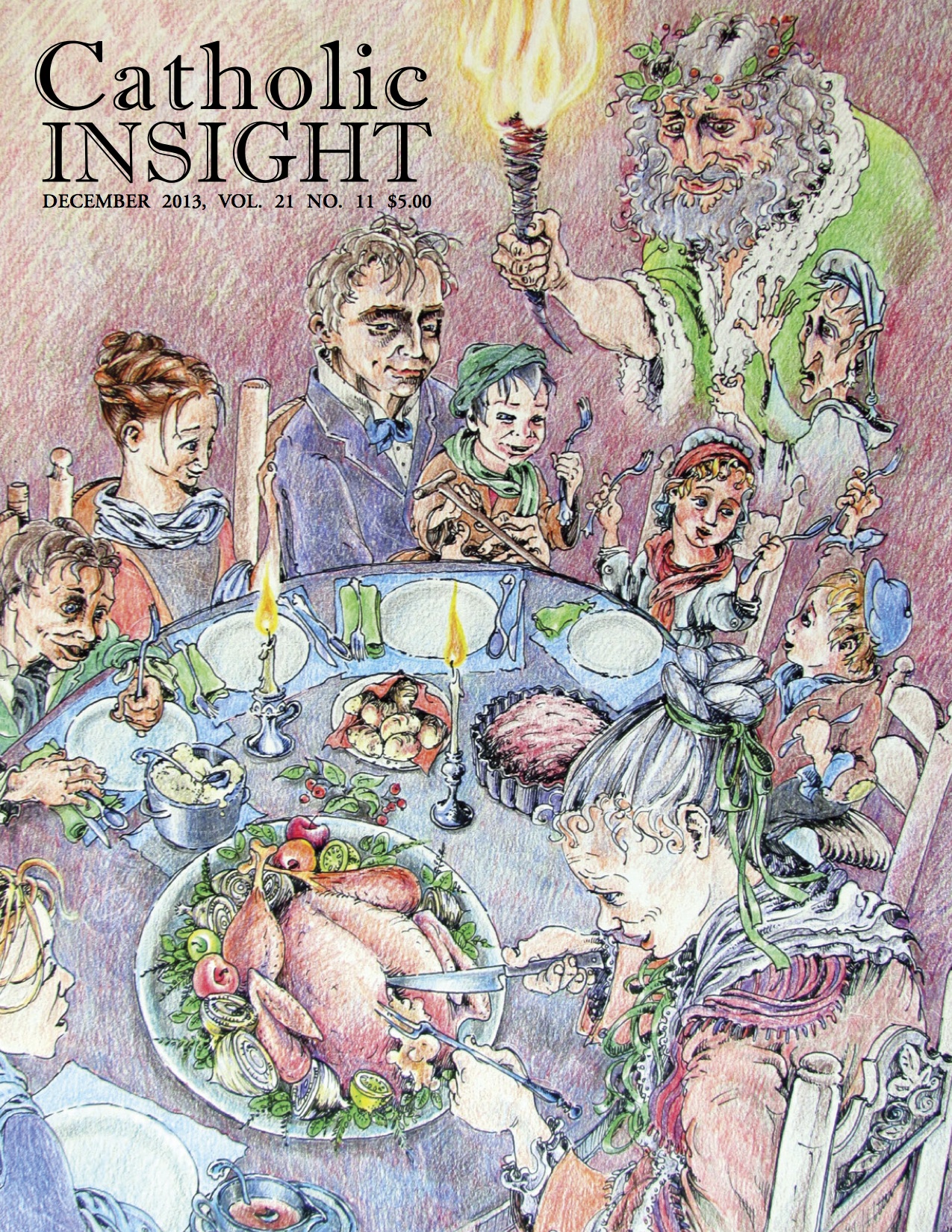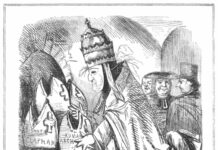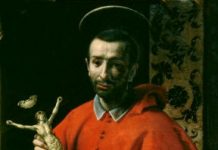Our December artist, Ben Hastings, is the sixth of ten children and was raised in Texas hill country and grew to adulthood in Alaska. He was baptized Catholic at fourteen and studied the liberal arts and the fine arts in college. He is thirty-three and currently living in North Carolina where he earns a living at the supermarket and works privately on art. Ben’s art can be seen at etsy.com/shop/TheBullandtheBristle.
What is this piece about?
This drawing illustrates a scene from A Christmas Carol, Dickens’ classic tale. It depicts the scene when the Ghost of Christmas Present leads Scrooge to his clerk’s home. The Cratchits are celebrating Christmas dinner with as much festivity as Bob’s pitiful salary can afford. There is no lack of affection or joy in the family, but Scrooge’s awakening conscience stirs a dreadful concern for Tiny Tim. The beauty of Dickens’ Carol is in its ingenuity—far from the peaceful descriptions of mangers and roasted chestnuts, this is a ghost story, straining every word to haunt a world of grumblers and shake us out of our grumbling.
When did you start drawing? Who did you learn from?
When commanded to “go play” as a toddler, I whiled away the hours with markers and scratch paper, piling up renditions of Superman and sports stars. My parents, not yet Catholic but undoubtedly under the influence of grace, devoted themselves with admirable fidelity to surrounding and informing their children with real beauty. My father altered the house with hand-built furnishings, designed by Mom and wrought with illustrative carvings; everything from Halloween costumes to science fair projects were crafted with care and luster under the guidance of Mom and Dad. In this environment my soul was taught the nature of art and beauty. When it came down to using pencils, brushes, and paper, my most influential teacher taught art at the public middle school. I sought his tutoring throughout my high school and college years. He made clear in his middle school classroom principles which are considered folly by the relativists in most college studios. There were years in adolescence, and later on during college, when I quit drawing. It was the desire to draw that drove me to find again that joy in life. The process of accumulating again the habit of drawing was a painful but happy revival. I am humbled by millions of better artists, and I still face the blank page with reluctance and anxiety, but it gets easier every time.
Why did you continue drawing? What attracts you to it?
Often I am drawn to illustrate a scene from a novel or Scripture, or to prepare a gift for a friend, or to sketch and paint landscapes when outdoors. I have recently illustrated a Halloween story written by my brother-in-law. Aside from college displays, I’ve had one showing in Alaska, a series of illustrations to the Book of Genesis. I do sell my artwork. I have some original drawings and paintings for sale. I have others which are available as prints, and I am open to commissions.
What is the purpose of art?
St. Augustine touches upon this subject when he addresses this question: Why did not God, who foresaw the fall of Lucifer, the fall of Adam and Eve, and all the evils that followed, instead create a world so perfect that no evil could exist in it? He uses the analogy of a painting to explain his answer. He says a painting would not be beautiful if it had no dark to contrast the light. In some mysterious way, darkness is necessary for the beauty of the whole. One of the essential attributes of beauty, according to St. Thomas, is harmony. I think Augustine’s idea of the necessary dark place may be akin to the notion of harmony, the mutual interdependence of the low and the high, which, by virtue of their relation to each other, begets this accordance which calms and lifts the soul.
I think that art is in some way an incarnation: it bears the truths of philosophy and theology in concrete persons and things and circumstances. This is more easily seen in the field of literature, which may be why I have such a bent towards illustration. But the visual arts themselves play a role. Beautiful paintings touch the soul and free the mind to better perceive and understand truth. Just as classical music produces order in the soul, so does gazing at beautiful artwork. When the passions are ordered, the intellect and the will are free to recognize and accept difficult truths.
What inspires you?
I am inspired by the way literature uses imagery, character, and setting to bear light on life and God’s mysterious work. I am particularly drawn to writers such as Flannery O’Connor and Walker Percy, but I am touched by the classics as well. My twenty years in Alaska largely formed my perception of nature, and I am inspired by landscapes wherever I go. From the intricate networks of great cities, to the mountains of Alaska, to the shaded neighbourhoods of the country, I have always made time for long walks with a sketchbook. Finally, I am inspired by the Church, those friends and loved ones whose lives of charity call me to give what I can of my talents.











